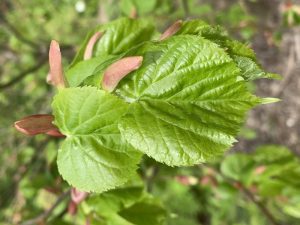Linden tree (Tilia cordata)
[Jaimie Sweetman is part of the Edible Forest located on the Yarra Valley Estate in Dixons Creek. There are regular tours of the Edible Forest – read more and book your place on a future tour.]
|
The Linden tree (Tilia cordata), sometimes called the small-leaved lime, is a deciduous tree originating in Europe, where it is widely grown as an ornamental tree, quite often as a street tree. It can grow up to 40m high, although it can be kept smaller or even hedged. The leaves, flowers and sap are all edible. The heart shaped leaves sprout in spring and, when soft, can be eaten straight off the tree, used as a lettuce substitute, added to salads or used to make pesto. The sap can be used as a sweet syrup (although I have not tried it yet). Come summer, when the leaves get tougher, they can still be dried and used as a herbal tea, as can the flowers that bloom in spring. The tea has a nice mild sweet flavour and is quite enjoyable. The health benefits include relieving coughs and congestion, as well as easing fevers and anxiety. There are around 30 species of Tilia but the linden tree is the one most considered as edible. In a food forest situation, it is a great first layer in the system creating shade and shelter for other plants. We currently have two in the Edible Forest. |
 One of the good things about edible trees is the minimal work that they require. There isn’t the annual turnover like vegetable crops. Rather, once planted, you have access to greens without any effort except for the harvesting.
One of the good things about edible trees is the minimal work that they require. There isn’t the annual turnover like vegetable crops. Rather, once planted, you have access to greens without any effort except for the harvesting.
